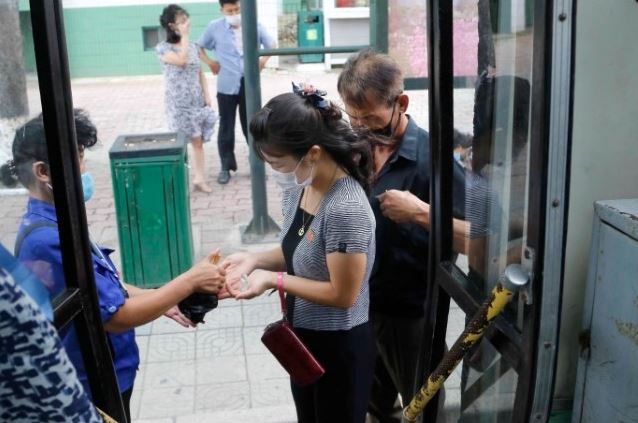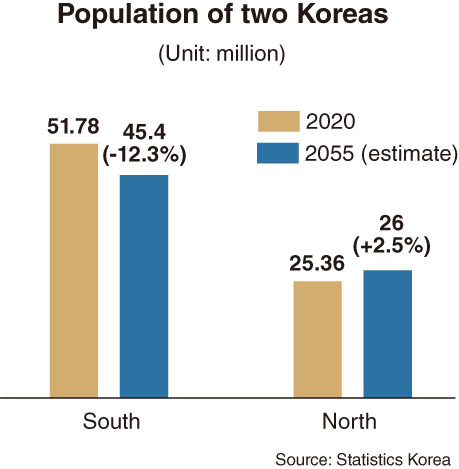[News Focus] Koreas to see population gap narrow
Data forecasts minus 6 million in South, plus 600,000 in North by 2055
By Kim Yon-sePublished : Oct. 28, 2020 - 16:18

SEJONG -- South Korea and North Korea have been posting a similar level of growth in demographic figures since 2000, according to data held by Statistics Korea.
The South saw its population increase by 10.1 percent over the past two decades to reach 51.78 million this year, while the figure for the North climbed 11.7 percent to 25.36 million.
But the government agency predicted that the two Koreas would see a divided pace -- negative growth for the South and positive for the North -- for the coming two decades.
The population is projected to decline 930,000 by 2040 in the South, while the North is expected to see its population increase 1.13 million to 26.49 million.
In 2055, the South and North are expected to post 45.4 million and 26 million in population, which indicates a drastic slide for the South and an overall maintenance (after peaking at 26.51 million in 2041) for its counterpart for the coming 35 years -- minus 6.38 million (minus 12.3 percent) for the South and plus 640,000 (plus 2.5 percent) for the North, compared to 2020 data.
The South saw its population increase by 10.1 percent over the past two decades to reach 51.78 million this year, while the figure for the North climbed 11.7 percent to 25.36 million.
But the government agency predicted that the two Koreas would see a divided pace -- negative growth for the South and positive for the North -- for the coming two decades.
The population is projected to decline 930,000 by 2040 in the South, while the North is expected to see its population increase 1.13 million to 26.49 million.
In 2055, the South and North are expected to post 45.4 million and 26 million in population, which indicates a drastic slide for the South and an overall maintenance (after peaking at 26.51 million in 2041) for its counterpart for the coming 35 years -- minus 6.38 million (minus 12.3 percent) for the South and plus 640,000 (plus 2.5 percent) for the North, compared to 2020 data.

Meanwhile, the collective figures for the two Koreas came to 77.14 million as of 2020, which is equivalent to the world’s No. 20, and right next to Germany with 83.78 million. The combined population outstrips Thailand (currently 20th) with 69.79 million, the UK (21st) with 67.88 million, France (22nd) with 65.27 million and Italy (23rd) with 60.46 million.
Statistics Korea forecast that the combined figure for the Peninsula, which stood at 69.71 million in 2000, would peak at 78.28 million in 2032.
The fertility rate of the South recorded 1.1 -- expected number of childbirths per woman in their lifetime -- in 2020, while the figure for North Korea reached 1.9.
Meanwhile, North Korea was found to have far exceeded the counterpart in the labor force participation rate.
In 2018, the latest year for which data is available, the economically active population for the South came to 27.89 million among those aged 15 or over (a total of 44.18 million people) a labor force participation rate of 63.1 percent. In contrast, the North posted a rate of 70.5 percent.
Data showed that nine years earlier, in 2009, the rates were similar -- 61 percent for the South and 61.3 percent for the North.
A government official said the relatively low increase in the participation rate in the South could be attributable to a sharp growth in the portion of elderly people.
“The percentage of seniors, aged 65 or over, in North Korea is staying at the 9 percent range (about 9.3 percent),” he said. “But the figure for South Korea has surpassed 16 percent.”
According to the Ministry of Interior and Safety, the nation’s portion of seniors was staying under 10 percent as of 2007, similar to the current figure for the North.
But in the wake of expanded lifespan -- women in particular -- and the plunged birthrates, the elderly population percentage reached an all-time high of 16.2 percent as of September 2020.
The South saw the portion of youth -- aged under 15 -- mark the record-low of 12.2 percent in September 2020, while the figure was 16.1 percent a decade earlier in September 2010.
By Kim Yon-se (kys@heraldcorp.com)








![[KH Explains] How should Korea adjust its trade defenses against Chinese EVs?](http://res.heraldm.com/phpwas/restmb_idxmake.php?idx=644&simg=/content/image/2024/04/15/20240415050562_0.jpg&u=20240415144419)










![[Today’s K-pop] Stray Kids to return soon: report](http://res.heraldm.com/phpwas/restmb_idxmake.php?idx=642&simg=/content/image/2024/04/16/20240416050713_0.jpg&u=)